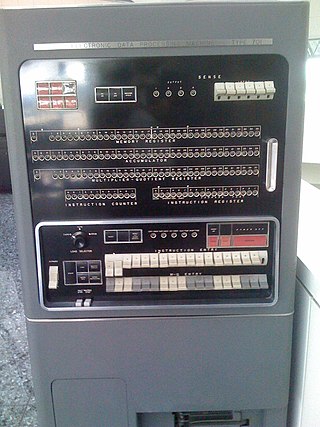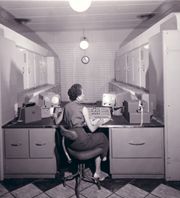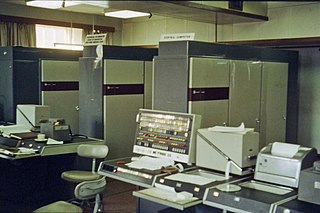
The IBM System/360 (S/360) is a family of mainframe computer systems that was announced by IBM on April 7, 1964, and delivered between 1965 and 1978. It was the first family of computers designed to cover both commercial and scientific applications and to cover a complete range of applications from small to large. The design distinguished between architecture and implementation, allowing IBM to release a suite of compatible designs at different prices. All but the only partially compatible Model 44 and the most expensive systems use microcode to implement the instruction set, which features 8-bit byte addressing and binary, decimal, and hexadecimal floating-point calculations.

The UNIVAC I was the first general-purpose electronic digital computer design for business application produced in the United States. It was designed principally by J. Presper Eckert and John Mauchly, the inventors of the ENIAC. Design work was started by their company, Eckert–Mauchly Computer Corporation (EMCC), and was completed after the company had been acquired by Remington Rand. In the years before successor models of the UNIVAC I appeared, the machine was simply known as "the UNIVAC".

The IBM 650 Magnetic Drum Data-Processing Machine is an early digital computer produced by IBM in the mid-1950s. It was the first mass produced computer in the world. Almost 2,000 systems were produced, the last in 1962, and it was the first computer to make a meaningful profit. The first one was installed in late 1954 and it was the most-popular computer of the 1950s.

The IBM 701 Electronic Data Processing Machine, known as the Defense Calculator while in development, was IBM’s first commercial scientific computer and its first series production mainframe computer, which was announced to the public on May 21, 1952. It was invented and developed by Jerrier Haddad and Nathaniel Rochester based on the IAS machine at Princeton.

The history of computing hardware starting at 1960 is marked by the conversion from vacuum tube to solid-state devices such as transistors and then integrated circuit (IC) chips. Around 1953 to 1959, discrete transistors started being considered sufficiently reliable and economical that they made further vacuum tube computers uncompetitive. Metal-oxide-semiconductor (MOS) large-scale integration (LSI) technology subsequently led to the development of semiconductor memory in the mid-to-late 1960s and then the microprocessor in the early 1970s. This led to primary computer memory moving away from magnetic-core memory devices to solid-state static and dynamic semiconductor memory, which greatly reduced the cost, size, and power consumption of computers. These advances led to the miniaturized personal computer (PC) in the 1970s, starting with home computers and desktop computers, followed by laptops and then mobile computers over the next several decades.

The Ferranti Mark 1, also known as the Manchester Electronic Computer in its sales literature, and thus sometimes called the Manchester Ferranti, was produced by British electrical engineering firm Ferranti Ltd. It was the world's first commercially available general-purpose digital computer. It was "the tidied up and commercialised version of the Manchester Mark I". The first machine was delivered to the Victoria University of Manchester in February 1951 ahead of the UNIVAC I, which was sold to the United States Census Bureau on 31 March 1951, although not delivered until late December the following year.
The DEUCE was one of the earliest British commercially available computers, built by English Electric from 1955. It was the production version of the Pilot ACE, itself a cut-down version of Alan Turing's ACE.

Pegasus was an early British vacuum-tube (valve) computer built by Ferranti, Ltd that pioneered design features to make life easier for both engineers and programmers. Originally it was named the Ferranti Package Computer as its hardware design followed that of the Elliott 401 with modular plug-in packages. Much of the development was the product of three men: W. S. (Bill) Elliott (hardware); Christopher Strachey (software) and Bernard Swann. It was Ferranti's most popular valve computer with 38 being sold. The first Pegasus was delivered in 1956 and the last was delivered in 1959. Ferranti received funding for the development from the National Research Development Corporation (NRDC).

International Computers and Tabulators or ICT was a British computer manufacturer, formed in 1959 by a merger of the British Tabulating Machine Company (BTM) and Powers-Samas. In 1963 it acquired the business computer divisions of Ferranti. It exported computers to many countries and in 1968 became part of International Computers Limited (ICL).

ReserVec was a computerized reservation system developed by Ferranti Canada for Trans-Canada Airlines in the late 1950s. It appears to be the first such system ever developed, predating the more famous SABRE system in the United States by about two years. Although Ferranti had high hopes that the system would be used by other airlines, no further sales were forthcoming and development of the system ended. Major portions of the transistor-based circuit design were put to good use in the Ferranti-Packard 6000 computer, which would later go on to see major sales in Europe as the ICT 1904.
UTEC was a computer built at the University of Toronto (UofT) in the early 1950s. It was the first computer in Canada, one of the first working computers in the world, although only built in a prototype form while awaiting funding for expansion into a full-scale version. This funding was eventually used to purchase a surplus Manchester Mark 1 from Ferranti in the UK instead, and UTEC quickly disappeared.
The FP-6000 was a second-generation mainframe computer developed and built by Ferranti-Packard, the Canadian division of Ferranti, in the early 1960s. It is particularly notable for supporting multitasking, being one of the first commercial machines to do so. Only six FP-6000s were sold before the computer division of Ferranti-Packard was sold off by Ferranti's UK headquarters in 1963, the FP-6000 becoming the basis for the mid-range machines of the ICT 1900, which sold into the thousands in Europe.
The Orion was a mid-range mainframe computer introduced by Ferranti in 1959 and installed for the first time in 1961. Ferranti positioned Orion to be their primary offering during the early 1960s, complementing their high-end Atlas and smaller systems like the Sirius and Argus. The Orion was based on a new type of logic circuit known as "Neuron" and included built-in multitasking support, one of the earliest commercial machines to do so.

The Atlas Computer was one of the world's first supercomputers, in use from 1962 to 1972. Atlas' capacity promoted the saying that when it went offline, half of the United Kingdom's computer capacity was lost. It is notable for being the first machine with virtual memory using paging techniques; this approach quickly spread, and is now ubiquitous.

The Manchester Mark 1 was one of the earliest stored-program computers, developed at the Victoria University of Manchester, England from the Manchester Baby. Work began in August 1948, and the first version was operational by April 1949; a program written to search for Mersenne primes ran error-free for nine hours on the night of 16/17 June 1949.
Ferranti's Sirius was a small computer released in 1961. Designed to be used in smaller offices without a dedicated programming staff, the Sirius used decimal arithmetic instead of binary, supported Autocode to ease programming, was designed to fit behind a standard office desk, and ran on UK standard mains electricity with no need for cooling. It was also fairly slow, with instruction speeds around 4,000 operations per second, and had limited main memory based on delay lines, but as Ferranti pointed out, its price/performance ratio was difficult to beat.
The Datamatic Division of Honeywell announced the H-800 electronic computer in 1958. The first installation occurred in 1960. A total of 89 were delivered. The H-800 design was part of a family of 48-bit word, three-address instruction format computers that descended from the Datamatic 1000, which was a joint Honeywell and Raytheon project started in 1955. The 1800 and 1800-II were follow-on designs to the H-800.
ICT 1900 was a family of mainframe computers released by International Computers and Tabulators (ICT) and later International Computers Limited (ICL) during the 1960s and 1970s. The 1900 series was notable for being one of the few non-American competitors to the IBM System/360, enjoying significant success in the European and British Commonwealth markets.
The RCA 501 was a transistor computer manufactured by RCA beginning in 1958.











